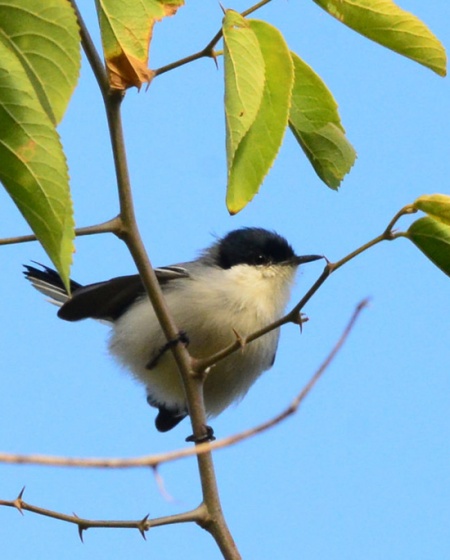- Polioptila plumbea
Identification
10-12.7 cm (4-5 in)
- Black crown, neck sides and stripe behind the eye
- Blue-grey upperparts
- Black wings with white edging on the tertials
- Long, thin black tail with narrow white tips and edges
- White face and belly
- Pale grey underparts
Female: similar to the male, but with a dark grey, rather than black, crown.
Young birds have a brown tinge to the upperparts and face, and whiter underparts.
Distribution
Central and South America:
Central America: found in Mexico, Guatemala, Honduras, Nicaragua, Costa Rica, Panama
South America: Colombia, Venezuela, Guyana, Suriname, French Guiana, Ecuador, Peru, Brazil
Taxonomy
White-lored Gnatcatcher has previously been included within Tropical Gnatcatcher but the split seems to be widely accepted.
The South American Classification Committee (SACC) seems convinced there is more than one species in the current Tropical Gnatcatcher, but not convinced about where the new species limits should be4.
Subspecies
This species currently has about 12 subspecies[1].
- P. p. brodkorbi: Lowlands of south-eastern Mexico (southern Veracruz) to eastern Nicaragua
- P. p. superciliaris: South East Mexico (Quintana Roo and Campeche) to Panama
- P. p. cinericia: Panama (Coiba and Pearl islands)
- P. p. bilineata: North Colombia to western Peru (northern Lima)
- P. p. anteocularis: North Colombia (upper Magdalena Valley)
- P. p. daguae: Colombia (upper Río Dagua and upper Río Patía)
- P. p. maior: Tropical eastern Peru (upper Río Marañón) from Piura to La Libertad
- P. p. plumbiceps: East slope of Andes of northern Colombia to northern Venezuela; Isla Margarita
- P. p. innotata: Extreme eastern Colombia to southern Venezuela and extreme northern Brazil
- P. p. plumbea: The Guianas and north-eastern Brazil (Rio Tapajós to northern Maranhão)
- P. p. parvirostris: Tropical eastern Peru (upper Amazon, Río Huallaga and Río Marañón)
- P. p. atricapilla: North East Brazil (Maranhão to Piauí, Ceará, Pernambuco and Bahia)
Habitat
Lowlands and foothills from sea level to about 1500 m. They occupy a wide of habitats from canopy of forests, forest edges, overgrown pastures and plantations etc.
Behaviour
Diet
Their main diet consists of small arthropods and spiders.
Breeding
The nest is a small cup made from vegetable fibres. The clutch consists of 2-3 white eggs with brown spots.
References
- Clements, J. F., T. S. Schulenberg, M. J. Iliff, D. Roberson, T. A. Fredericks, B. L. Sullivan, and C. L. Wood. 2017. The eBird/Clements checklist of birds of the world: v2017, with updates to August 2017. Downloaded from http://www.birds.cornell.edu/clementschecklist/download/
- Avibase
- Handbook of the Birds of the World Alive (retrieved Sept 2017)
- SACC as viewed on 2007-11-18: http://www.museum.lsu.edu/~Remsen/SACCBaseline09.html
- The Beauty of Birds
Recommended Citation
- BirdForum Opus contributors. (2024) Tropical Gnatcatcher. In: BirdForum, the forum for wild birds and birding. Retrieved 26 April 2024 from https://www.birdforum.net/opus/Tropical_Gnatcatcher






